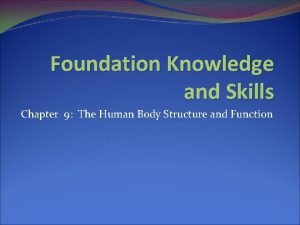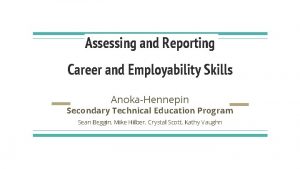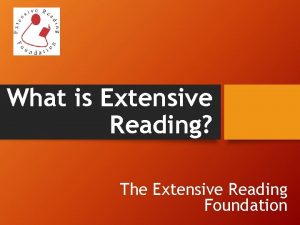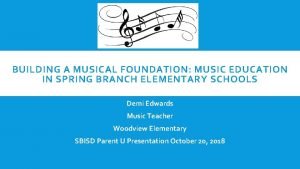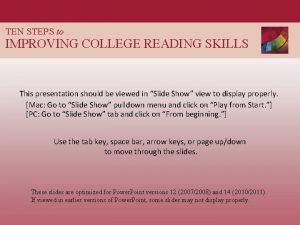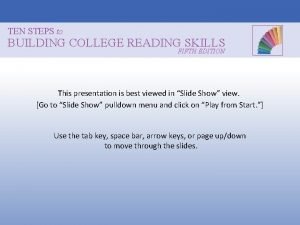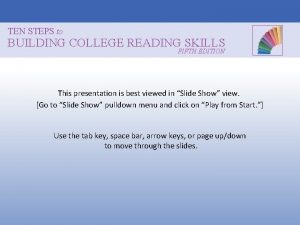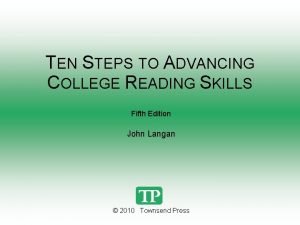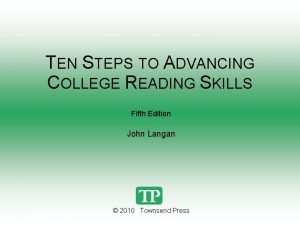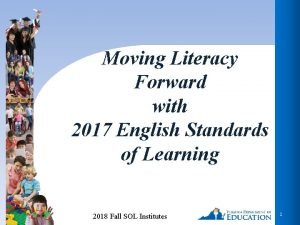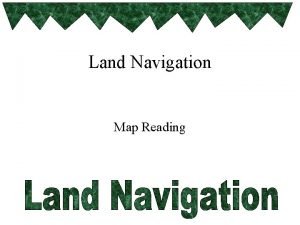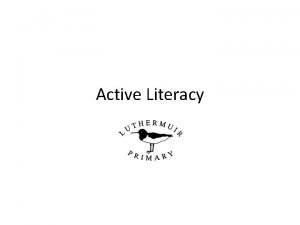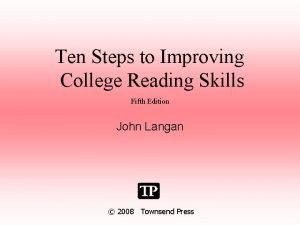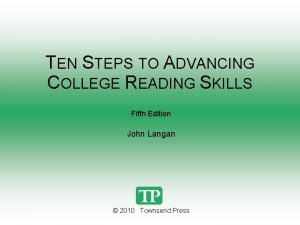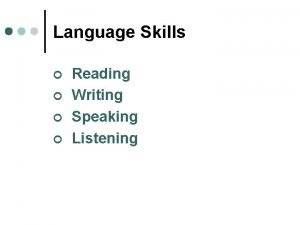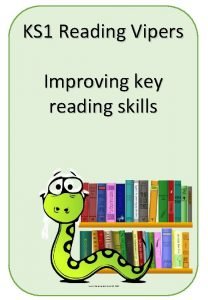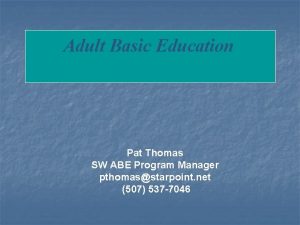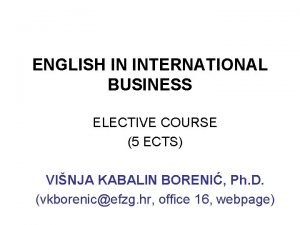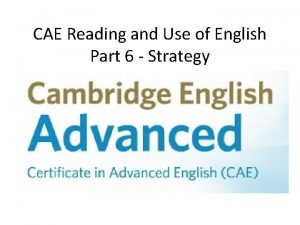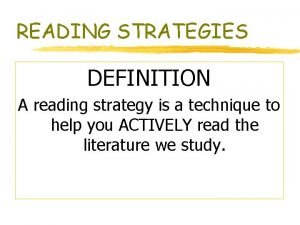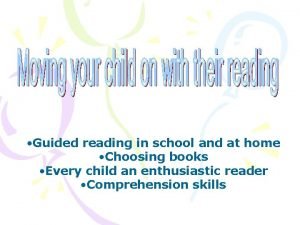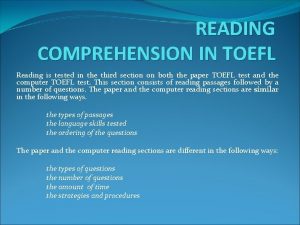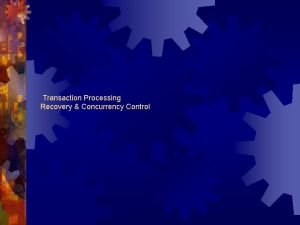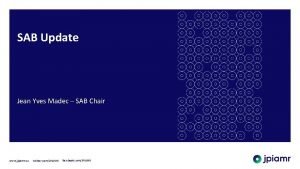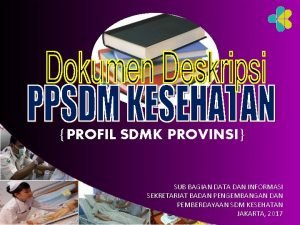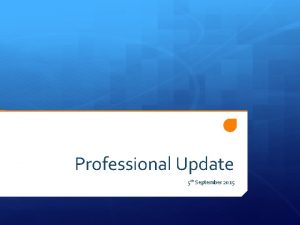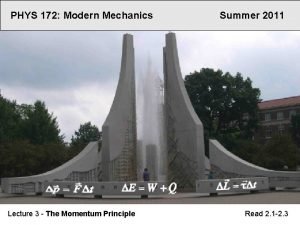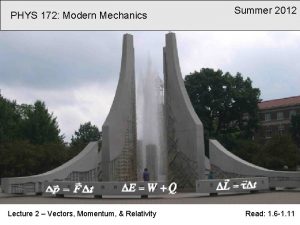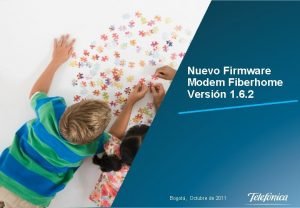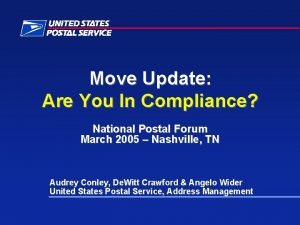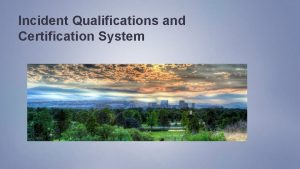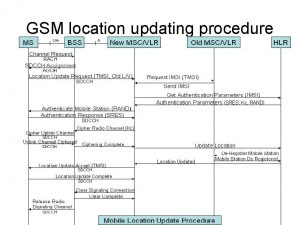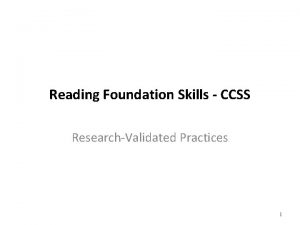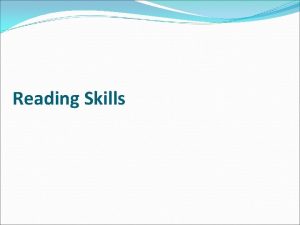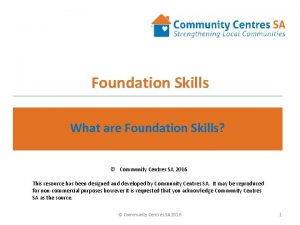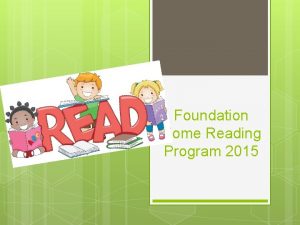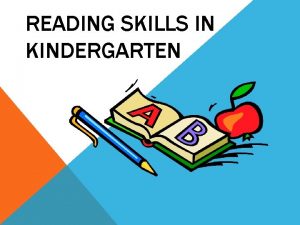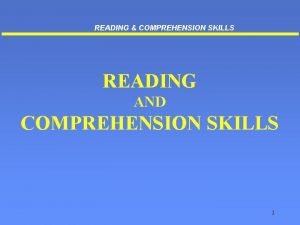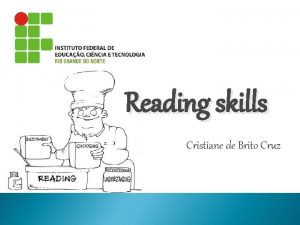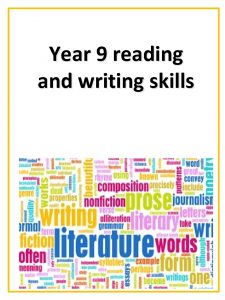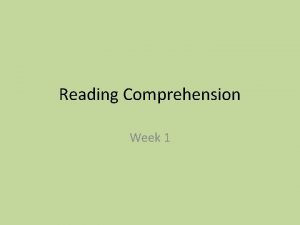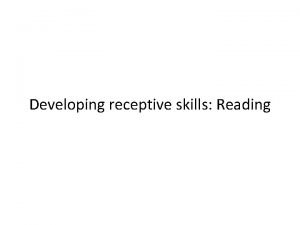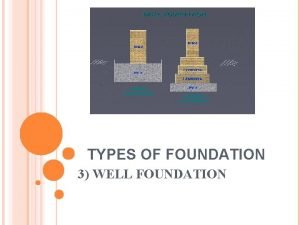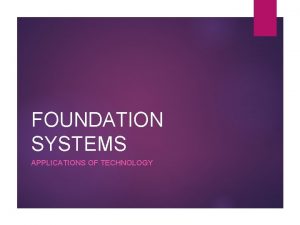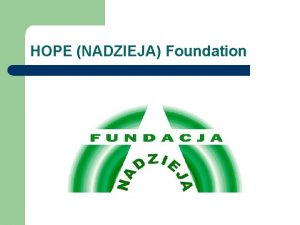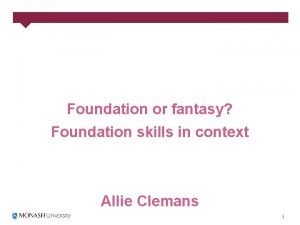Reading Foundation Skills Update on ResearchValidated Practices 1

































































- Slides: 65

Reading Foundation Skills Update on Research-Validated Practices 1

Anita L. Archer, Ph. D. Author, Consultant, Teacher archerteach@aol. com www. explicitinstruction. org 2

Reading Foundation Skills – Update on Research-Validated Practices In this session, Dr. Archer will review current research on the importance of establishing a strong reading foundation in the primary grades including instruction on print concepts, phonological awareness, decoding, sight vocabulary and fluency. 3

Recommended IES Practice Guide Foundational Skills to Support Reading for Understanding in Kindergarten Through 3 rd Grade Available online 4

Recommended Book Kilpatrick, D. A. (2015). Essentials of assessing, preventing, and overcoming reading difficulties. Hoboken, New Jersey: John Wiley & Sons. 5

Recommended Book Willingham, D. T. (2017). The Reading Mind: A cognitive approach to understanding how the mind reads. San Francisco, California: Jossey. Bass. 6

Recommended Book Seidenberg, M. (2017). Language at the speed of sight. New York: Basic Books. 7

Simple View of Reading Decoding (Word-Level Reading) Ability to transform print into spoken language Language Comprehension Ability to understand spoken language Word-level reading and oral language comprehension are relatively independent abilities. Gough, 1986

Simple View of Reading Language Comprehension Decoding Print Concepts Decoding Skills Understand the organization and basic features of print Phonological Awareness Demonstrate understanding of spoken words, syllables, and sounds (phonemes) Fluency (accuracy, rate, expression) Read with sufficient accuracy and fluency to support comprehension Phonics and Word Recognition Word Knowledge (sight vocabulary) Know and apply grade-level phonics and word analysis skills in decoding words Instant and effortless access to all, or almost all, words read.

Why – Foundation Decoding Skills Students who learn the alphabetic system and can decode effortlessly reap many benefits including: - focus mental energy on comprehension - experience joy of engagement with text - access a wide range of texts - increase vocabulary and knowledge (Brady, 2012) 10

Why – Foundation Decoding Skills Research indicates that students have better future prospects as readers if they develop understanding and facility with the alphabetic code by the end of second grade. (Moats 2012) 11

Why – Foundation Decoding Skills If we do not catch students early (by end of second grade at the latest), improvement in their relative standing is much less likely and cost much more. Many reading disabilities can be remediated or ameliorated by the end of first grade with explicit, phonics-emphasis instruction. (Ryder, Tunmer, & Greaney, 2008; Mathes et al, 2005) 12

Why – Foundation Decoding Skills Poor readers in grades 3 – 5 needed about two hours per day to bring their basic reading skills up to the level predicted by their verbal reasoning abilities. (Torgesen et. al 2001) 13

Simple View of Reading Language Comprehension Decoding Print Concepts Decoding Skills Understand the organization and basic features of print Phonological Awareness Demonstrate understanding of spoken words, syllables, and sounds (phonemes) Fluency (accuracy, rate, expression) Read with sufficient accuracy and fluency to support comprehension Phonics and Word Recognition Word Knowledge (sight vocabulary) Know and apply grade-level phonics and word analysis skills in decoding words Instant and effortless access to all, or almost all, words read.

Print Concepts Letter Names • Teach letter names explicitly. • Utilize a version of the Alphabet Song. • Introduce upper-case letter names before lowercase because they are visually easier to learn. Adams 2013 15

Print Concepts Letter Names • Teach to mastery – Letters can be named accurately, confidently, effortlessly. • Provide extra time on: – Visually similar (b, d, p, q) – Upper and lower case forms that differ (E e, R r) 16

Print Concepts Additional notes: b and d reversals are not a sign of dyslexia. Dyslexia is NOT rooted in visual problems. Willingham, 2017 17

Simple View of Reading Language Comprehension Decoding Print Concepts Decoding Skills Understand the organization and basic features of print Phonological Awareness Demonstrate understanding of spoken words, syllables, and sounds (phonemes) Fluency (accuracy, rate, expression) Read with sufficient accuracy and fluency to support comprehension Phonics and Word Recognition Word Knowledge (sight vocabulary) Know and apply grade-level phonics and word analysis skills in decoding words Instant and effortless access to all, or almost all, words read.

Phonological Awareness Skills • Early – – rhyming alliteration segment words into syllables identify initial sound in word • Basic – blending sounds into words – segmenting words into sounds • Advanced – manipulating phonemes – deleting, substituting Kilpatrick, 2015 19

Phonemic Awareness • • • Include phonemic awareness activities in beginning reading programs for students of any age. Kindergarten: 10 - 15 minutes a day (Foorman et al, 1997) First Grade: (First three months) 10 minutes a day incorporated into phonics instruction Intervention: Within intervention program if student reads below 2 nd grade level Intervention: Advanced phonemic awareness may be necessary for struggling readers (Kilpatrick, 2015) All Elementary Grades: Incorporate into spelling instruction. 20

Phonemic Awareness - How? Phonemic awareness activities should be: 1. Few in number 2. Explicitly modeled At-risk students need additional explicit instruction. 3. Supported by concrete materials or gestures 4. Designed to include all students 21

Example A • Blending Sounds into Words 1. We’re going to play a say-the-word game. I’ll say the sounds. You say the word. 2. Listen. aaaammmmm 3. What word? am 4. (Repeat with other words. ) 5. (If time permits, check individual students. ) (Practice: man, sat, ship, trap) 22

Example B • Segmenting words into sounds Smooth Segmenting 1. Put your fists together. 2. Get ready to stretch the word. 3. The word is fin. What word? fin 4. Stretch it. fffiiiiinnnn 5. Shrink it. fin 6. (If time permits, check individual students. ) (Practice: sit, list, fish, trip) 23

Example C • Segmenting Words into Sounds Separate Segmenting 1. We’re going to say the sounds in a word. 2. Fist in the air. Put up one finger for each sound. 3. The word is sat. What word? sat 4. First sound? /sss/ Next sound? /aaa/ Last sound? /t/ 5. (If time permits, check individual students. ) (Practice: fan, fast, shop, with) 24

Simple View of Reading Language Comprehension Decoding Print Concepts Decoding Skills Understand the organization and basic features of print Phonological Awareness Demonstrate understanding of spoken words, syllables, and sounds (phonemes) Fluency (accuracy, rate, expression) Read with sufficient accuracy and fluency to support comprehension Phonics and Word Recognition Word Knowledge (sight vocabulary) Know and apply grade-level phonics and word analysis skills in decoding words Instant and effortless access to all, or almost all, words read.

Phonics and Word Recognition • Letter-sound associations √ Consonant and vowel letters √ Consonant teams including: - blends - digraphs √ Vowel teams including: - digraphs - diphthongs - r-controlled vowels • Decoding of regular, single syllable words 26

Phonics and Word Recognition - What? • Structural elements including: √ Inflectional endings √ Prefixes √ Suffixes • Decoding of multisyllabic words • Reading of irregular words in which letters don’t represent most common sounds • Reading decodable text 27

Letter – Sound Associations • Letter-Sound Knowledge involves pairing visual memory with phonological memory. • “Letter-sound knowledge is essential for both phonic decoding and for storing words in one’s sight vocabulary. ” (Kilpatrick, p. 64) • If students have difficulty with letter-sound associations, not visual memory but phonological memory. (Kilpatrick, p. 33) 28

Letter-Sound Associations • Good readers rely primarily on the letters in a word rather than context or pictures to identify/pronounce familiar and unfamiliar words. (Ehri, 1994; Kilpatrick, 2015; Seidenberg, 2017) 29

Letter-Sound Associations - How? • Utilize a well-organized, systematic sequence to introduce the most common letter-sound associations. – Easy to difficult. (Example: single vowel letters before digraphs) – High frequency before low frequency letter-sound associations. (Example: m, a, f before j, x and z) – Separate easily confused letter-sound associations. (Example: e and i, n and m, b and d) • Provide explicit instruction (rather than implicit instruction) to introduce letter-sound associations. • Differentiate between continuous and stop sounds. Continuous Sounds Stop Sounds - 30

Example Teaching Letter-Sound Associations sat 1. (Point to example word. ) This word is sat. 2. (Point to the underlined grapheme. ) This sound is /aaaa/. 3. What sound? /aaaa/ OR a 1. (Point to the isolated grapheme. ) This sound is /aaaa/. 2. Say the sound with me. /aaaa/ 3. What sound? /aaaa/ 31

Letter-Sound Associations Fun facts about Letter-Sound associations: Finnish, Spanish, and Italian have a one to one correspondence between letters and sounds. Kids learn to decode quite quickly in these countries. English, French, Danish, and Portuguese have “one to many” systems and readers lag behind in primary grades. However, by fourth grade readers in these countries catch up. Willingham, 2017 32

Decoding Process Using Letter – Sound Associations (Willingham, 2017) 33

Phonics - regular words • Ability to blend individual sounds into recognizable words is a critical component of reading. (Beck, 2006) • Students who receive systematic phonics instruction have better comprehension at the end of 2 nd and 3 rd grades. (Kilpatrick, 2015) • Diverse learners must be encouraged to look carefully at spelling and sounds and to repeatedly sound out and blend words. (Reitsma, 1983; Kilpatrick, 2015) 34

Phonics regular words • Utilize instructional routines to introduce specific types of words. • Pair decoding and encoding of words. – Decoding and encoding rely on the same underlying knowledge. (Joshi, 2008 – 2009; Moats, 2005 – 2006) – Linking spelling and decoding instruction deepens children’s knowledge of the written system. (Brady 2012; Yopp, Hallie, & Yopp, 2011) • Provide practice reading decodable text. 35

Example A - Sound by Sound Blending Sounding Out VC, CVCC, CCVC words mom top shop dot 1. (Write the first letter on the board. ) What sound? 2. (Write the second letter on the board. ) What sound? 3. (Move your hand under the two letters. ) Blend it. 4. (Write third letter. ) What sound? 5. (Move your hand under the letters. ) Blend the sounds. 6. What word? 36

Example B - Continuous Blending Sounding Out VC, CVCC, CCVC words sip fit lip tip rim 1. When I touch a letter, I’ll say its sound. I’ll keep saying the sound until I touch the next letter. I won’t stop between sounds. 2. My turn to sound out this word. (Touch under each letter and say the sound. Hold continuous sounds. Say stop sounds quickly. Don’t stop between sounds. ) 3. Sound out this word with me. (Touch under each letter. ) 4. Your turn. Sound out this word by yourselves. (Touch under each letter. ) 5. What word? (Glide your finger under the word. ) 37

Example C Sounding Out Words with Letter Combinations rain train paint sail seal Precorrection Procedure 1. (Point to the underlined letters. ) What sound? 2. (Point to the word. ) What word? 3. (Have students reread the list without the precorrection. ) 4. (Have individual students read the words or have them read the words to their partner. ) 38

Example D - CVCE words - Sound Blending like mine fit fine 1. 2. 3. 4. 5. (Point to the first letter. ) What sound? (Point to the vowel and final e. ) What sound? (Point to the consonant. ) What sound? (Glide finger under the word. ) Blend it. What word? 39

Example E - Decoding Words with Onset Rime 1. (Point to rime. ) What part? an 2. Get ready to read words that end with an. 3. (Point to new word. ) What word? ran 4. (Point to next word. ) What word? fan 5. (Continue with additional word. ) man Stan pan fan plan ban can Jan • Note: Reading “word families” is an excellent way to build word reading fluency. Practice the “word family” until students are very fluent. Use choral reading and partner reading. 40

High frequency rimes (phonograms) -at -an -ap -ack -ail -ain -ake -ale -ame -ash -ate -aw -ay -ell -eat -est -ip -ice -ine -ide -ick -ing -ink -ight -in -ill -oke -ore -ot -op -ock -ug -ump -unk 41

Phonics and Word Recognition Orthographic Knowledge Orthographic knowledge refers to the patterns and principles by which spoken language is correctly represented in writing. What is permissible and impermissible in English Examples Every word/syllable has a vowel. NOT tbl Doubled letters in English but NOT tripled letters. NOT talll Often referred to as SPELLING 42

Phonics and Word Recognition • “It turns out we don’t read letter by letter, we read in letter clumps, figuring out a few letters at a time. ” Willingham, 2017 • Learning common patterns in words ight, alk, ook mis, pre, pro, dis ing, ed, es ence, ance, tion 43

Decoding Process Using Letter-Sounds and Spelling (Willingham, 2017) 44

Decoding Strategy for Long Words 1. 2. 3. 4. Say the parts fast. Say the word. Ask yourself Is it a real word? Does it make sense? 45

Decoding of Multisyllabic Words How • Rather than using rigid, rule-directed syllabication to divide words into parts, students are taught to recognize the parts in a flexible manner. (Archer et al. 2003, 2006; Bhattacharya & Ehri, 2004) • Putting words into “decodable chunks” using prefixes, suffixes, and vowels should be stressed. (Archer et al. 2006) 46

Example Decoding of Multisyllabic Words (Loop, Loop Strategy) (Preparation: Segment the word into decodable chunks. Be sure that prefixes and suffixes are separate parts. Draw loops to segment the words. ) instruction 1. 2. 3. commitment (Move finger under the first part. ) What remarkable part? (Repeat for remaining parts. ) (Move finger quickly under the parts. ) part? 4. What word? 5. Is that a real word? What part? What 47

Simple View of Reading Language Comprehension Decoding Print Concepts Decoding Skills Understand the organization and basic features of print Phonological Awareness Demonstrate understanding of spoken words, syllables, and sounds (phonemes) Fluency (accuracy, rate, expression) Read with sufficient accuracy and fluency to support comprehension Phonics and Word Recognition Word Knowledge (sight vocabulary) Know and apply grade-level phonics and word analysis skills in decoding words Instant and effortless access to all, or almost all, words read.

Distinction between Three Terms √ High frequency words -Only 100 words account for approximately 50%of the words in English print. (Fry, Fountoukidis, & Polk, 1985) -Only 13 words (a, and, for, he, is, in, it, of, that, the, to, was, you) account for 25% of words in print. (Johns, 1980) √ Irregular words -Words that cannot be sounded out accurately using the most common sounds for graphemes. - Many high frequency words are irregular. √ Sight vocabulary -Words that are recognized instantly. -The quick and automatic recognition of most common words appearing in text is necessary for fluent reading. (Blevins, 1998) 49

Irregular Words • Irregular words in English – Nearly all English words represent every sound in the spoken word, even if they represent some sounds irregularly. – Most irregular words have only one irregular letter – sound association. Examples: been, from, both More than one irregular letter – sound association one once sugar bouquet 50

Example Irregular Words - Sounding Out was 1. (Write the word on the board. ) Sound out this word. /waaaasssss/ 2. (Say the word in a sentence. ) Tom /waaaassss/ in the room. 3. Is that a real word? no 4. What do we say? was 5. (Carefully examine the word with the students, determining the “tricky” part of the word. ) 51

Word Knowledge (sight vocabulary) • How do students remember words they no longer need to sound out? • False Assumption: Students use visual memory to remember words as they would in remembering the label for a book or table. • Research Conclusion: Brain activity is NOT the same for naming objects and reading words. (Kilpatrick, p. 30) 52

Word Knowledge (sight vocabulary) • How do students remember words they no longer need to sound out? • We input written words visually but we do not store them visually. Kilpatrick, p. 33 • Words are stored: – orthographically (spelling) – phonologically (pronunciation) – semantically (meaning) 53

Word Knowledge (sight vocabulary) • How do students remember words they no longer need to sound out? Notes of interest: • From second grade on, skilled readers only need one to four exposures for a word to become a sight word. • The speed with which children in lst and 2 nd turn an unfamiliar word into a sight word is a KEY PREDICTATOR of those who will struggle later. (Kilpatrick, p. 35) 54

Simple View of Reading Language Comprehension Decoding Print Concepts Decoding Skills Understand the organization and basic features of print Phonological Awareness Demonstrate understanding of spoken words, syllables, and sounds (phonemes) Fluency (accuracy, rate, expression) Read with sufficient accuracy and fluency to support comprehension Phonics and Word Recognition Word Knowledge (sight vocabulary) Know and apply grade-level phonics and word analysis skills in decoding words Instant and effortless access to all, or almost all, words read.

Fluency • The ability to effortlessly read words accurately and quickly. • The ability to read connected text accurately with appropriate rate and expression (prosody). (Judson, Mercer, & Lane, 2000) 56



Factors Effecting Rate 1. Proportion of words in text that are recognized as “sight words”. Sight words include any word that readers have practiced reading sufficiently often to be read from memory. ” (Ehri, 2002) 2. Speed of decoding strategies used to determine the pronunciation of unknown words. 3. Speed with which word meanings are identified. 1. Speed at which overall meaning is constructed. 59

Fluency • Fluency is related to reading comprehension. (Cunningham & Stanovich, 1998; Fuchs, & Maxwell, 1988; Jenkins, Fuchs, Espin, van den Broek, & Deno, 2000; Rasinksi, 2011; Samuels, 2006; Shanahan, 2010 ) • When students read fluently, decoding requires less attention. Attention can be given to comprehension. (Samuels, Schermer, &Reinking, 1992) 60

Fluency PRACTICE PRACTICE and more PRACTICE 61

Fluency Procedure #1. Provide extensive reading practice. Utilize procedures such as augmented silent reading, choral reading, cloze reading, and partner reading. Procedure #2. Encourage wide independent reading. – Read interesting text at reading level to build fluency. (Carnegie, 2010) – To build fluency students should read materials that are not too challenging but not too easy. (Moats, 1998) 62

Fluency Procedure #3. Provide repeated reading practice at the word level. When reading word lists, have students reread word lists until competent. Procedure #4. Utilize repeated reading exercises in passages to increase fluency. (Chard et. al, 2002) 63

Let us not forget. • Comprehension is built on the foundation skills of decoding and fluency. 64

Thank You May you thrive as an educator. 65
 Is an alternative of log based recovery
Is an alternative of log based recovery While reading activities
While reading activities Shallow pad foundation
Shallow pad foundation Composition of urine
Composition of urine Employability skills
Employability skills Foundation standard 4 employability skills
Foundation standard 4 employability skills Foundation standard 4 employability skills
Foundation standard 4 employability skills Foundation standard 4 employability skills
Foundation standard 4 employability skills Foundation knowledge and skills
Foundation knowledge and skills Foundation knowledge and skills
Foundation knowledge and skills Foundation standard 4 employability skills
Foundation standard 4 employability skills Extensive reading foundation
Extensive reading foundation Reading musical foundation
Reading musical foundation Hippocampus reading foundation
Hippocampus reading foundation Intrapersonal skill
Intrapersonal skill What is a soft skill
What is a soft skill Ontario skills passport
Ontario skills passport Ten steps to improving college reading skills 6th edition
Ten steps to improving college reading skills 6th edition Ten steps to advanced reading
Ten steps to advanced reading Ten steps to building college reading skills
Ten steps to building college reading skills Ten steps to advancing college reading skills answers
Ten steps to advancing college reading skills answers Ten steps to advancing college reading skills
Ten steps to advancing college reading skills What is intensive reading
What is intensive reading Reading skills progression chart
Reading skills progression chart Spur vs draw
Spur vs draw Basic reading skills
Basic reading skills Receptive skills listening and reading
Receptive skills listening and reading Reading comprehension pyramid
Reading comprehension pyramid Ten steps to advancing college reading skills
Ten steps to advancing college reading skills Ten steps to advancing college reading skills
Ten steps to advancing college reading skills Slidetodoc. com
Slidetodoc. com Reading vipers
Reading vipers Southwest abe
Southwest abe Reading skills in business communication
Reading skills in business communication Characteristics of intensive reading
Characteristics of intensive reading Cae reading and use of english part 6
Cae reading and use of english part 6 Definition of reading strategy
Definition of reading strategy Reading vipers summarise
Reading vipers summarise How to develop reading skills in students
How to develop reading skills in students Guardian consonant
Guardian consonant Juan rodriguez cabrillo was a portuguese-born
Juan rodriguez cabrillo was a portuguese-born Round robin reading vs popcorn reading
Round robin reading vs popcorn reading What are the aims of teaching reading
What are the aims of teaching reading Edb net section
Edb net section Critical reading is an active and reactive process.
Critical reading is an active and reactive process. What is extensive reading
What is extensive reading For adult
For adult Zechariah
Zechariah Zechariah 4:8
Zechariah 4:8 University community plan
University community plan Temporary update problem in dbms
Temporary update problem in dbms Www sab update com
Www sab update com Lnes
Lnes Update data sisdmk
Update data sisdmk Teacher prd examples
Teacher prd examples Position update formula
Position update formula Position update formula
Position update formula Fiberhome firmware update
Fiberhome firmware update Move update compliance
Move update compliance Mdh situation update
Mdh situation update Iqcs
Iqcs Cucm native call queuing
Cucm native call queuing 811 locate request
811 locate request Gsm location update procedure
Gsm location update procedure Chrome update
Chrome update Dhl ocean freight market update
Dhl ocean freight market update








